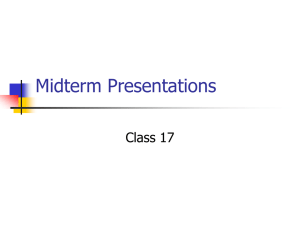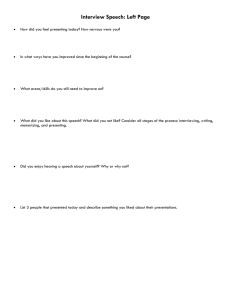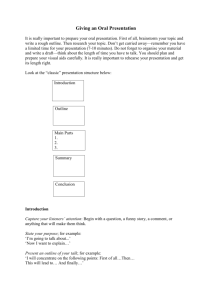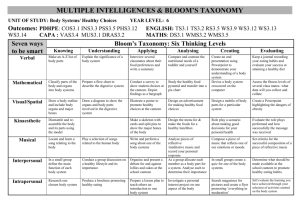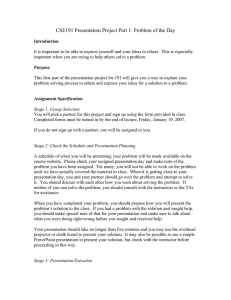“YEAR 6 HENTY HEADLINER” Teacher Manual
advertisement
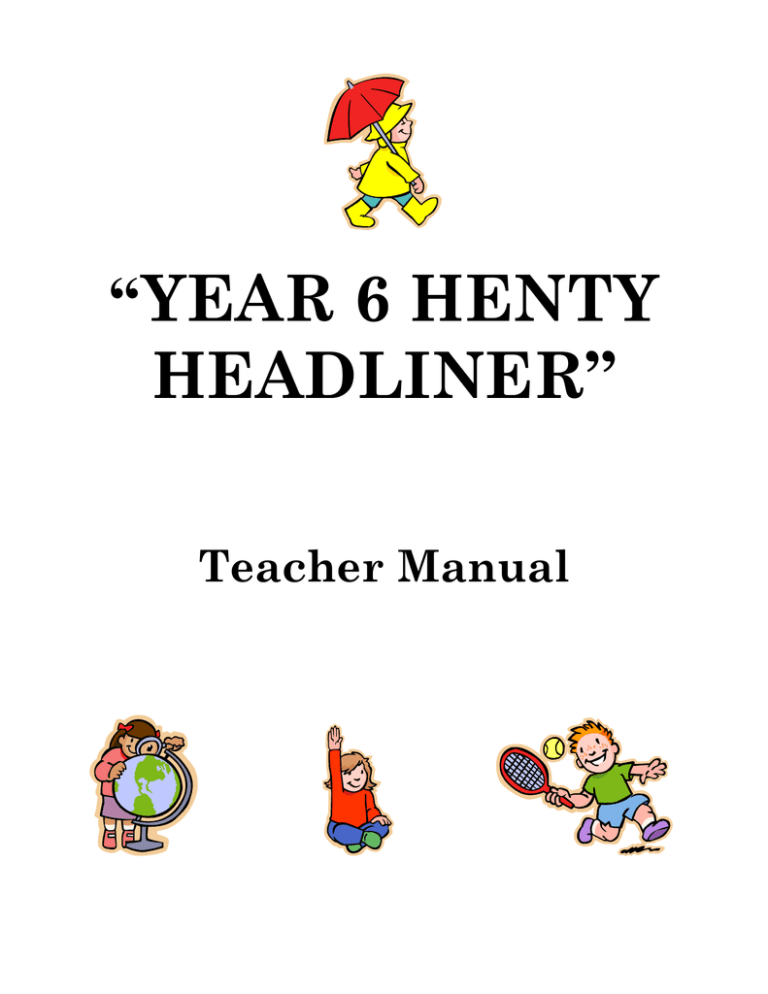
“YEAR 6 HENTY HEADLINER” Teacher Manual INTRODUCTION TO THE PROJECT: Year Six Henty Headliner is a news broadcasting program developed by Speech Pathology Students at Charles Sturt University, for the grade six class at Henty Primary School. The program is a fortnightly presentation which covers five areas which include: Master of Ceremony and Joke of the Week presenter News Presenter x 2 Sports Presenter x 2 Class of the Week presenter x 2 and Weather Presenter plus one helper There will also be two Stage Managers who are in charge of setting up the stage and putting out all of the props. These people are also responsible for packing away the stage and props. Year Six Henty Headliner is a great way for the students to build confidence, improve on research and interviewing skills and oral skills. Not to mention the students have fun, presenting the news, wearing professional outfits, and presenting to the school. This teacher’s manual contains the manuals that were written for the students for each role, however this manual contains yellow text boxes which provides information of how each role applies to the syllabus. TEACHERS ROLE: Although this is primarily run by the students, your role as the teacher is to act as the “overlooker”. In order to run a smooth presentation, the teacher should do the following 1. Firstly make sure all the students know when they will be presenting and what role they are taking in the presentation. 2. Allocate time once or twice a fortnight for the students presenting to research and write their speeches. Two Half-hour sessions should be plenty of time for the students to research and write a one minute speech. The computer room is a perfect place to research and write their speeches. 3. Emphasise to the presenters the importance of rehearsing. A recommendation would be those who are presenting practice in front of the class. 4. The speeches should be given to the teacher to proof-read at least 2 days before the presentation. This ensures that their speeches are appropriate and well written. 5. Allocate time on the day of presentation for the stage managers to set up the stage. 6. After the presentation, the stage managers should then pack up the stage. Class members can help with this task also. 7. After the presentation, the teacher should then ensure that those people who are presenting in the following fortnight, know who they are and the role they are taking. RECOMMENDATIONS FOR SUSTAINABILITY: In order to effectively sustain this project, many steps can be put in place so the project reaps the benefits it can provide. 1. To gain the most out of the project allocate class time for research and report writing. By doing so the students understand this is a requirement and not something they may or may not choose to do in their own time at home. 2. If bringing the whole school to watch the news presentation is not possible, then presenting the news program to the remainder of the class is acceptable. 3. As the teacher, try to promote this project as a grade six project, solely run by the students. You are there as a guide, so encourage independency. If the students do have problems completing their task, encourage the children to seek the help of their peers and the manuals, which have been specifically designed to assist in every aspect of the task. The manuals were designed so the students could refer to the manuals and be able to produce a sound speech, with little help from the teacher. The project only takes up a small amount of class time however the benefits of doing such a project make the project extremely worth while. The students build independency, confidence in public speaking, research and writing skills and have fun while doing so. It is a great way for them to learn about news, sport, weather as well as the skills that come with researching and writing and presenting the items. Please enjoy the program created by Charles Sturt University Speech Pathology Students and we hope you enjoy the benefits it provides for the students and the school. MASTER OF CEREMONY AND JOKE OF THE WEEK YOUR ROLE: Your role as the Master of ceremony is to introduce the news program and each person presenting something to the school. You are also responsible for telling the school a joke of the week! PROPS YOU WILL NEED: Pretend microphone Big yellow bow tie (for joke of the week) HOW TO WRITE AN INTRODUCTION TO THE NEWS PROGRAM AND EACH ITEM BEING PRESENTED: Before you begin, make sure you have the names of all those people that are presenting and what they are presenting for that week. You begin your presentation by welcoming everybody to Year Six Henty Headliner. You then introduce the first item. Your introduction speeches must be short and precise. They must include who is presenting and what they will be presenting. For example: “Please welcome Jane who will be presenting the local news this week.” Or “Please give a warm welcome to John who is here to give us a report on what year 4/5 have been up to this week.” TS3.2 Interacts productively and with autonomy in pairs and groups of various sizes and composition, uses effective oral presentation skills and strategies and listens attentively. Please do not just say “Jane will present the news.” Instead you could say “Jane will now tell you what Henty has been up to this week in sport. Please welcome her” After someone has presented it is your turn to introduce the next person. Before you do so, please thank the person who has just given their presentation. For example: “Thankyou Jane for that interesting news story. Now it is time for John to tell us what exciting news grade 4/5 is up to this week.” Write down your introductions on a small piece of paper in order from the first to last presenter so you can have them to look at when speaking to the audience. The order for presenting is: 1. Welcome to the Year Six Henty Headliner 2. News Presenters 3. Classroom of the Week 4. Sport 5. Weather 6. Joke of the Week (This is your job! You don’t need to introduce yourself but say something like “and before we finish and to end on a funny note, I will now tell you all a joke!” 7. Conclusion- thank everyone who presented and the audience for listening. TS3.1 Communicates effectively for a range of purposes and with a variety of audiences to express well developed, well organised ideas dealing with more challenging topics. Once you have written your speech make sure you proof read it and edit the speech to ensure that you have included all information and that it flows nicely. Your speech should also be presented to your teacher so they can proof read it as well. You are then ready to present! HOW TO FIND A JOKE: It is up to you to find an APPROPRIATE joke to tell the rest of the school. Please make sure it will aim at all grades. It might be a good idea to tell the joke to the rest of the grade six class first to make sure it is appropriate and funny! Your classmates may also have an idea for a joke that they can tell you! Once all items and your joke have been presented you conclude the program by thanking all those who presented and hoping that the audience has enjoyed the presentation. TIPS FOR PRESENTING YOUR ROLE AS MASTER OF CEREMONIES AND JOKE PRESENTER: Once you have written your introductions and joke of the week you are ready to present! But not before you do some quick steps to make sure your presentation is ready for everybody to hear. 1. Rehearse, rehearse, rehearse!! Practice makes perfect! 2. Remember to speak clearly 3. Always speak at a good speed. Not too fast and not too slow…just right! 4. Practice using an appropriate volume. You need to make sure everybody can hear you. So no shouting or whispering! WS3.10 Uses knowledge of sentence structure, grammar and punctuation to edit own writing. 5. Stand up straight and pretend to be confident (even if your not!) Keep your chin up so your voice can stream out to everybody and not to the floor! 6. Make eye contact. This is really important to keep the audience’s attention and will make the audience listen. Once you have practiced, keeping in mind everything mentioned above, you are ready to present a fantastic speech!! Good Luck! NEWS PRESENTERS YOUR ROLE: Your roles as news presenters is to research and present one local news item and one national news item OR you might like to present two national news items OR two local news items. The duration of the presentation need only last 1-2 minutes. PROPS YOU WILL NEED: Tie or Bow tie to wear World map Red arrows HOW TO RESEARCH: Many resources are available for you to find local and national news. The newspaper is an excellent source and even your local Border Mail or The Daily Advertiser will have national news as well as local news. To find these newspapers on the internet visit: http://www.bordermail.com.au OR http://www.dailyadvertiser.com.au These sites will include some national news but if you would like more of a broad range of national news go to: http://www.sydneymorningherald.com.au You can also watch news on the television. Normally local news is at 6.00pm on channel nine (Win) every week day and national news is at 7:00pm on channel nine and ABC. Just listen out for any stories that interest you and write out some main points to talk about in your speech. You can also find articles by buying your local news paper and searching through to find local and national news that interests you. Once you have found an article, read through it making sure you write down any key facts or information that you would like to include in your presentation. Once you have all the important facts about the news item it is now time to write a speech! HOW TO PLAN AND WRITE YOUR SPEECH: Your speech must contain enough information so the audience can understand the basics of what is being reported. Remember, your speech should only last 1-2 minutes. Your speech should contain the following three areas: An introduction The main points A conclusion WS3.9 Produces a wide range of well-structured and well-presented literary and factual texts for a wide variety of purposes and audiences using increasingly challenging topics, ideas, issues and written language features. Before you write or type your speech, you must take into consideration some important factors. 7. Your introduction should begin to tell the audience what your story is going to be about. The introduction should “catch” the audience’s attention. If possible begin your presentation with a sentence that will make the audience want to know more. WS3.12 Produces texts in a fluent and legible style and uses computer technology to present these effectively in a variety of ways. For example, you might like to begin a sentence with “Something peculiar happened in Sydney today” or “An exciting event is to take place in Henty this weekend.” This will make the audience sit up and listen to what you will say next. 8. The main bulk of your speech should contain the most information. You may like to jot down information to act as a checklist to make sure you do not miss out on any information. 9. Your conclusion is how you “wrap” your story up. This may include further information such as “If you would like more information please contact Henty Primary School”. At the end of writing your speech, read through it to make sure you can answer the following points: Who (Who was involved in the news story) When (When did the news story take place) Where (Where did the news story take place) and What (What was the news story about) You should also add extra information to make your presentation more interesting and knowledgeable. Please do not just state who, when, where and what as this will only shorten your presentation. Once you have written your speech make sure you proof read it and edit the speech to ensure that you have included all information and that it flows nicely. Your speech should also be presented to your teacher so they can proof read it as well. You are then ready to present! WS3.10 Uses knowledge of sentence structure, grammar and punctuation to edit own writing. HOW TO USE THE PROPS: A world map is provided so you can show the audience where a news story is located around the world. If you are presenting a news story which is happening in America, you can place a big red arrow (provided in the props box) pointing to America. In order to do this, you must be familiar as to where countries are. So make sure you find out where the country is (using an atlas from the library) and place the arrow on the appropriate country before you get up on stage. HOW TO GIVE A SPEECH: Once you have written your speech you are ready to present! But not before you do some quick steps to make sure your presentation is ready for everybody to hear. 1. Rehearse, rehearse, rehearse!! Practice makes perfect! 2. Remember to speak clearly 3. Always speak at a good speed. Not too fast and not too slow…just right! 4. Practice using an appropriate volume. You need to make sure everybody can hear you. So no shouting or whispering! 5. Stand up straight and pretend to be confident (even if your not!) Keep your chin up so your voice can stream out to everybody and not to the floor! 6. Make eye contact. This is really important to keep the audience’s attention and will make the audience listen. Once you have practiced, keeping in mind everything mentioned above, you are ready to present a fantastic speech!! Good Luck! TS3.1 Communicates effectively for a range of purposes and with a variety of audiences to express well developed, well organised ideas dealing with more challenging topics. CLASS INTERVIEWERS YOUR ROLE: Your role as class interviewers is to interview a chosen classroom to find out what activities they are doing in their classroom for that week. This might include an excursion the class is going on or a particular theme that they are learning about for that week. PROPS: Bow ties HOW TO CONDUCT AN INTERVIEW: You need to find out as much information as possible so question choice is very important. Possible questions could be: TS3.2 Interacts productively and with autonomy in pairs and groups of various sizes and composition, uses effective oral presentation skills and strategies and listens attentively. 1. Have you been on an excursion this week? 2. If so, where did you go and what did you do? 3. What did you learn from going on this excursion? If the class did not go anywhere you might like to interview the class on anything exciting that they have been learning about in the classroom. Possible question could be: 1. What are you learning about this week? 2. What is something interesting that you have learnt? 3. Is there anything that your class in making to help your learning? TS3.1 Communicates effectively for a range of purposes and with a variety of audiences to express well developed, well organised ideas dealing with more challenging topics. Think of some other questions that would be relevant when finding out what a class is up to. A student might have some really exciting news that will interest everybody or the class may be learning about something that everybody should know. To conduct the interview with your chosen classroom you must do the following: 1. Organise a time with the teacher for you to come into the classroom and ask the students what they have been up to. 2. Have a list of questions already written out for you to ask with some space for their answers 3. Write down as much information as possible so you can compile enough information for your speech 4. Once you have enough information, thank the students and the teacher! You might like to ask if you could borrow anything that might help your presentation. For example if they are learning about Australian Animals and have done a poster on them, you might like to borrow it to show the rest of the school. HOW TO WRITE UP YOUR INTERVIEW AS A SPEECH: The speech should only be a minute in duration. To make sure you have written a solid speech, please make sure you have the following: 10. Introduce what class you have interviewed 11. Introduce what the class has been doing during that week TS3.1 Communicates effectively for a range of purposes and with a variety of audiences to express welldeveloped, well-organised ideas dealing with more challenging topics. 12. Further include information that will tell the audience as much as you know about the class activities. 13. Make sure you include: a. What the class is doing b. Who is involved (it might be that in a 3/4 class, only the grade 4’s are being interviewed as they might be doing something interesting that the grade 3’s are not) WS3.12 Produces texts in a fluent and legible style and uses computer technology to present these effectively in a variety of ways. c. What they learnt that week or what they did that week and d. What they will be doing in the future, for example if they are learning about Australian Animals in the classroom, they might be going on an excursion to an Australian Animal museum. e. You can conclude your presentation by telling the audience how the class has felt about learning about learning about the topic. Once you have written your speech make sure you proof read it and edit the speech to ensure that you have included all information and that it flows nicely. Your speech should also be presented to your teacher so they can proof read it as well. You are then WS3.10 Uses knowledge of sentence structure, grammar and punctuation to edit own writing. ready to present! HOW TO GIVE A SPEECH: Once you have written your speech you are ready to present! But not before you do some quick steps to make sure your presentation is ready for everybody to hear. 14. Rehearse, rehearse, rehearse!! Practice makes perfect! 15. Remember to speak clearly 16. Always speak at a good speed. Not too fast and not too slow…just right! 17. Practice using an appropriate volume. You need to make sure everybody can hear you. So no shouting or whispering! 18. Stand up straight and pretend to be confident (even if your not!) Keep your chin up so your voice can stream out to everybody and not to the floor! 19. Make eye contact. This is really important to keep the audience’s attention and will make the audience listen. Once you have practiced, keeping in mind everything mentioned above, you are ready to present a fantastic speech!! Good Luck! TS3.1 Communicates effectively for a range of purposes and with a variety of audiences to express well developed, well organised ideas dealing with more challenging topics. SPORTS PRESENTERS YOUR ROLE: Your role as sports presenters is to research and present one local sporting item and one national sporting item OR you might like to present two national sporting items OR two local sporting items. The duration of the presentation need only last 1-2 minutes. PROPS YOU WILL NEED: Bow Ties HOW TO RESEARCH: Many resources are available for you to find sporting news. The newspaper is an excellent source and even your local Border Mail or The Daily Advertiser will have national sport as well as local sport. To find these newspapers on the internet visit: http://www.bordermail.com.au OR http://www.dailyadvertiser.com.au These will include some national news but if you want more of a broad range of national sport go to http://www.sydneymorningherald.com.au You can also find articles by buying your local news paper and searching through to find a sporting article that interests you. Once you have found an article, read through making sure you write down any key factors or information that you would like to include in your presentation. Once you have all the important facts about the sporting item it is now time to write a speech! HOW TO PLAN AND WRITE YOUR SPEECH: Your speech must contain enough information so the audience can understand the basics of what is being reported. Remember, your speech should only last 1-2 minutes. Your speech should contain the following three areas: An introduction The main points A conclusion Before you write or type your speech, you must take into consideration some important factors. 20. Your introduction should begin to tell the audience what your story is going to be about. Include the basics: Who (Who was involved in the news story) When (When did the news story take place) Where (Where did the news story take place) and What (What was the news story about) The introduction should “catch” the audience’s attention. If possible begin your presentation with a sentence that will make the audience want to know more. For example, you might like to begin a sentence with “Henty will take on Culcairn in what should be a thrilling match in this weekends Football game.” This will make the audience sit up and listen to what you will say next. WS3.9 Produces a wide range of well-structured and well-presented literary and factual texts for a wide variety of purposes and audiences using increasingly challenging topics, ideas, issues and written language features. WS3.12 Produces texts in a fluent and legible style and uses computer technology to present these effectively in a variety of ways. 21. The main bulk of your speech should contain the most information. You may like to jot down information about your story to act as a checklist to make sure you don’t miss out on anything. 22. Add adjectives (describing words). This makes the presentation much more interesting. Instead of saying “Henty Netball team played against Culcairn on the weekend winning 40-39.” You could say “Henty played a thrilling game of netball on the weekend against Culcairn, winning by just one point. The game was tightly matched the whole way through until Henty shot the winning goal minutes before time. Henty is now through to the semi- finals on the weekend. Good Luck Henty!” The use of “thrilling” and “tightly matched” draws the attention on the audience and makes them sit up and listen. 23. You should also include a conclusion to “wrap” your story up. This may include further information such as “If you would like information on how to become a member of you local swim team, please contact Heather on 0260565245”. Once you have written your speech make sure you proof read it and edit the speech to ensure that you have included all information and that it flows nicely. Your speech should also be presented to your teacher so they can proof read it as well. You are then WS3.10 Uses knowledge of sentence structure, grammar and punctuation to edit own writing. ready to present! HOW TO PRESENT YOUR SPORTS STORY: Once you have written your speech you are ready to present! But not before you do some quick steps to make sure your presentation is ready for everybody to hear. 1. Rehearse, rehearse, rehearse!! Practice makes perfect! 2. Remember to speak clearly 3. Always speak at a good speed. Not too fast and not too slow…just right! 4. Practice using an appropriate volume. You need to make sure everybody can hear you. So no shouting or whispering! TS3.1 Communicates effectively for a range of purposes and with a variety of audiences to express well developed, well organised ideas dealing with more challenging topics. 5. Stand up straight and be confident (even if your not!) Keep your chin up so your voice can stream out to everybody and not to the floor! Remember, being grade sixes, everybody looks up to you, so do not be scared as they’re going to think your great no matter what. 6. Make eye contact. This is really important to keep the audience’s attention and will make them listen. Once you have practiced, keeping in mind everything mentioned above, you are ready to present a fantastic speech!! Good Luck! WEATHER PRESENTER YOUR ROLE: Your role as the weather presenter is to research and present the local weather and the weather of all capital cites. The duration of the presentation need only last 1-2 minutes. PROPS YOU WILL NEED: Map of Australia Weather pictures Pointing stick Yellow raincoat (if its going to rain in Henty) Flower necklace (if it is going to be sunny in Henty) HOW TO RESEARCH: Many resources are available for you to find the weather forecast. The newspaper is an excellent source and even your local Border Mail or The Daily Advertiser will have national weather as well as local weather. Due to Henty being a small town, the newspaper does not specifically forecast Henty weather, so use the weather of your nearest major town, which is Wagga Wagga. To find weather forecasts on the internet visit: http://www.bordermail.com.au OR http://www.dailyadvertiser.com.au These papers will include national weather but if you want a newspaper which is specifically national weather go to WS3.12 Produces texts in a fluent and legible style and uses computer technology to present these effectively in a variety of ways. http://www.sydneymorningherald.com.au To find the extended weather forecast (weather forecast for the whole week) for each capital city visit: http://www.weather.com.au Once you are at the website click on one of the states (eg New South Wales) located on the left side of the page. Next you need to click on the city you would like to find the weather report for (eg Sydney). This will show you the weather forecast for this city for the whole week. RS3.5 Reads independently an extensive range of texts with increasing content demands and responds to themes and issues. You can also find the weather report by buying your local newspaper or watching the weather report at the end of the news on the television. Normally local news is at 6.00pm on channel nine (Win) every week day and national news is at 7:00pm on channel nine and ABC. Once you have found the weather for the capital cities and Henty, write down all information that will help you in your presentation. Once you have all the important facts about the weather it is now time to write a speech! HOW TO PLAN AND WRITE UP A SPEECH: Your speech must contain enough information so the audience can understand the basics of what is being reported. Remember, your speech should only last 1-2 minutes. For each weather report for each town you must include the name of the town, the temperature for that day and the description of that weather. RS3.6 Uses a comprehensive range of skills and strategies appropriate to the type of text being read. For example: “Henty will be fine and sunny today with a top of 24 degrees. Some cloud will develop late afternoon and showers are expected overnight.” This tells us where we are talking about, the temperature of the day and a description on the weather Before you begin you must familiarize yourself with some weather terminology. Cloudy Showers Fine Sunny Overcast (clouds developing ) Thunder Lightening Windy Frost (ice forming over night) Storm Fog Late change (either sunny in morning then rain or rain in the morning then sunny) Mainly fine (sun with some cloud) Some words you might like to use are underlined to describe the weather Showers clearing Early frost then fine Becoming fine after a shower or two Partly cloudy WS3.9 Produces a wide range of well-structured and well-presented literary and factual texts for a wide variety of purposes and audiences using increasingly challenging topics, ideas, issues and written language features. The weather report might like to also include the wind direction Light southerly winds North westerly winds Moderate southerly winds Gail warnings for Port Philip Bay The weather report that you find your information from should include wind directions so look closely to find this information. Once you have written your speech make sure you proof read it and edit the speech to ensure that you have included all information and that it flows nicely. Your speech should also be presented to your teacher so they can proof read it as well. You are then ready to present! WS3.10 Uses knowledge of sentence structure, grammar and punctuation to edit own writing. HOW TO USE THE PROPS: You as the weather person will have use of the weather map (Australia map)! You will put pictures onto the weather board to describe the weather in Henty and other capital cities. You should do this before you present to the school, so when you actually do present you are not trying to find the different pictures. Instead, place them on the weather map before you reach the stage so once you are up there you can just use a pointer to point to which town you are talking about. HOW TO PRESENT YOUR WEATHER PRESENTATION: Once you have written your speech you are ready to present! But not before you do some quick steps to make sure your presentation is ready for everybody to hear. 24. Rehearse, rehearse, rehearse!! Practice makes perfect! 25. Remember to speak clearly WS3.13 Critically analyses own texts in terms of how well they have been written, how effectively they present the subject matter and how they influence the reader. 26. Always speak at a good speed. Not too fast and not too slow…just right! 27. Practice using an appropriate volume. You need to make sure everybody can hear you. So no shouting or whispering! 28. Stand up straight and be confident (even if your not!) Keep your chin up so your voice can stream out to everybody and not to the floor! Remember, being grade sixes, everybody looks up to you, so do not be scared as they’re going to think your great no matter what. 29. Make eye contact. This is really important to keep the audience’s attention and will make them listen. Once you have practiced, keeping in mind everything mentioned above, you are ready to present a fantastic speech!! Good Luck!

